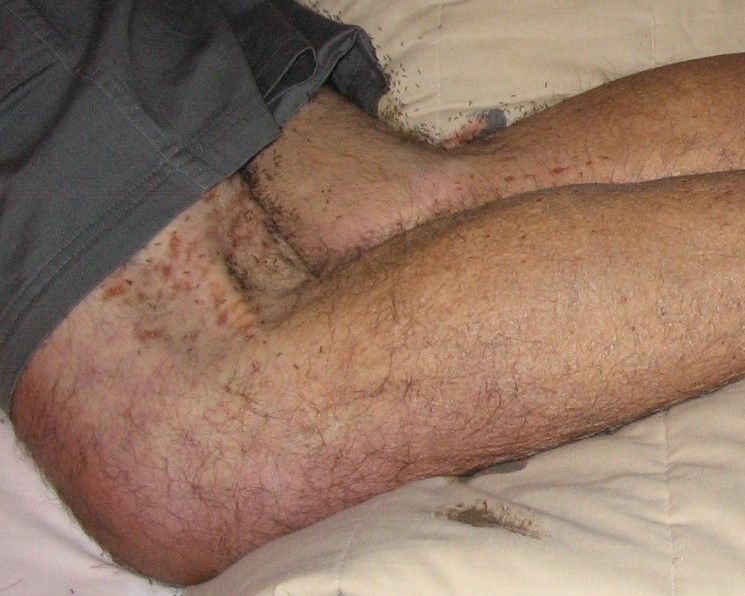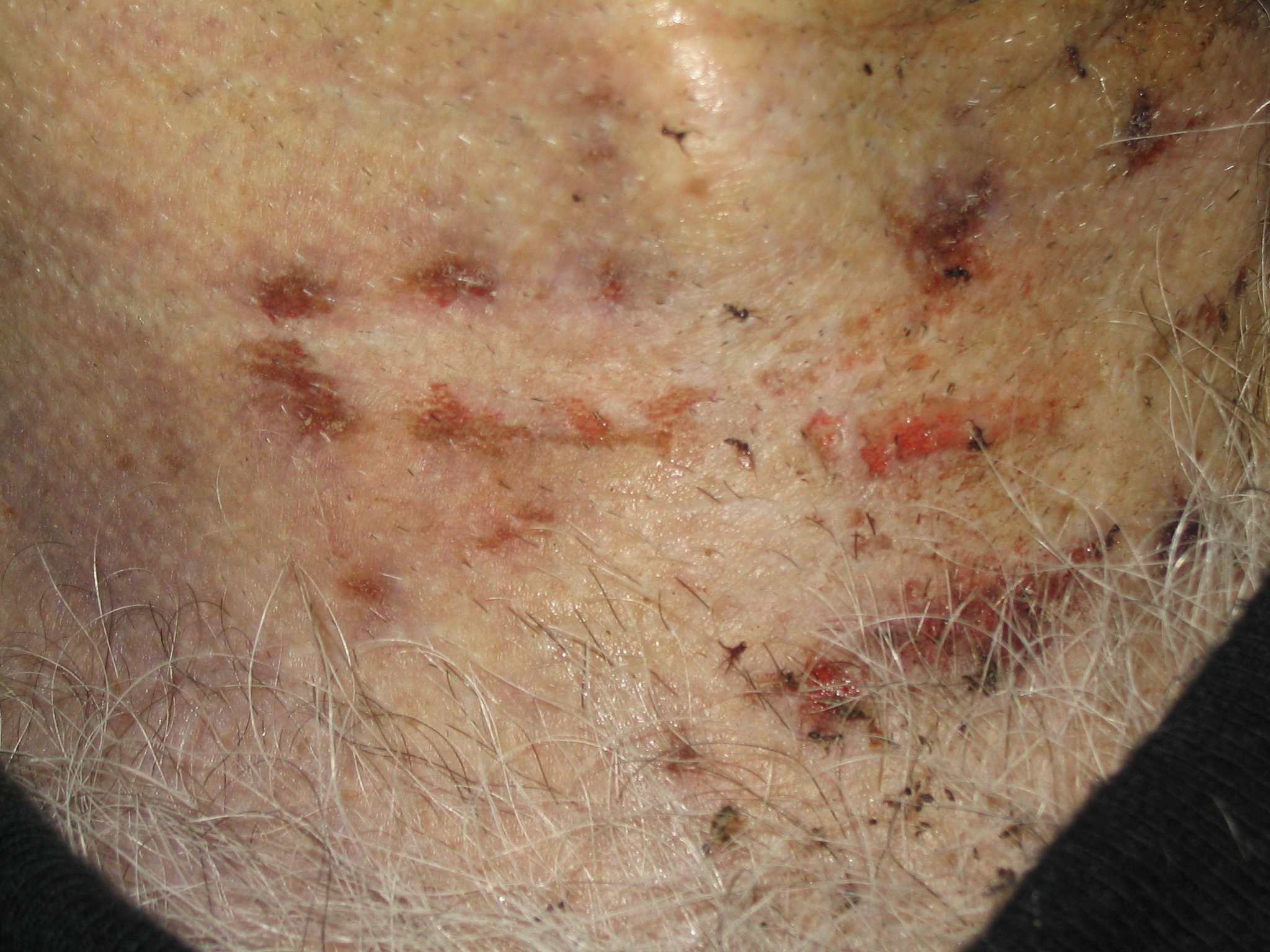Table of Contents
Definition / general | Essential features | Antemortem insect feeding | Postmortem insect feeding | Procedural recommendations for the forensic pathologist | Clinical images | Additional references | Board review style question #1 | Board review style answer #1 | Board review style question #2 | Board review style answer #2Cite this page: Truong LV, Banerjee P. Forensic entomology. PathologyOutlines.com website. https://www.pathologyoutlines.com/topic/forensicsentomology.html. Accessed April 24th, 2024.
Definition / general
- Forensic entomology is the study of insects / arthropods pertaining to its applications to medicolegal and criminal death investigations
- Predictable sequence of insect colonization on a decomposing body is known as insect succession (PLoS One 2018;13:e0195785)
- Insect succession depends on whether physical obstructions to oviposition are present and if conditions are suitable for oviposition (PLoS One 2018;13:e0195785)
- Insect succession patterns, developmental age of immature insects and environmental data are used to estimate the postmortem interval (Forensic Sci Int 2011;211:67)
- Blow flies are regarded as the primary and most accurate forensic indicators of time of death (J Med Entomol 1991;28:565)
- Larval stages of flies are called maggots
- Maggot movement through bodily fluids, especially prior to pupation, adult fly meal regurgitation and adult fly waste products may confound bloodstain pattern interpretation at the crime scene or during autopsy (Forensic Sci Int 2003;137:152)
Essential features
- Uses:
- Substantiate cases of neglect (Forensic Sci Int 2001;120:155, Forensic Sci Int 2004;146:S195)
- Alternative sample for toxicology (J Forensic Leg Med 2019;67:28)
- Alternative sample for human DNA identification (J Forensic Sci 2001;46:685)
- Detect postmortem relocation (PeerJ 2017;5:e3506)
- Correlation of period of insect activity with a postmortem interval (PLoS One 2018;13:e0195785, Int J Legal Med 2007;121:90)
- Tissue destruction and lesions caused by postmortem insect feeding activity may resemble or obscure antemortem injuries (Int J Legal Med 2019;133:307)
- Insect feeding activity may begin in the antemortem phase and continue postmortem, especially in cases of neglect and abuse (Forensic Sci Int 2001;120:155, Forensic Sci Int 2004;146:S195)
- Antemortem feeding (myiasis) may be a contributor to the cause of death as opposed to a postmortem artifact (J Forensic Sci 2002;47:542)
- Tissue sampling of candidate postmortem artifacts for histology is useful to confirm the postmortem nature of the lesion (Int J Legal Med 2019;133:307)
Antemortem insect feeding
- Not all forensically important insects wait until death to feed (Forensic Sci Int 2004;146:S195)
- Medical conditions and wounds can produce chemoattractants and provide substrates for necrophagous insects to feed (e.g. diabetes, ulcers, sores, wounds) (J Forensic Sci 2002;47:542)
- Larval myiasis can be fatal (Forensic Sci Int 2004;146:S195)
- While a low number of maggots can be used therapeutically to debride wounds, a large enough maggot mass can damage and destroy healthy tissue through buildup of larval waste products and secondary invaders in the form of predators, which may introduce harmful microorganisms into the wound site (Trends Parasitol 2001;17:176)
- Some fly species have larva that may opportunistically switch to feeding on living tissue to overcome feeding competition within a large enough maggot mass (Forensic Sci Int 2004;146:S195)
- Indicator of neglect or abuse
- Usual movement by living organisms and changing environmental conditions deters fly progeny deposition (Forensic Sci Int 2004;146:S195)
- Incapacitated individuals are unable to interrupt fly activity, allowing surface deposition of fly egg or larva (Forensic Sci Int 2004;146:S195)
- Exposed body fluids and waste products are powerful chemoattractants for several species of flies (Forensic Sci Int 2001;120:155)
- Indicator of caregiver neglect (Forensic Sci Int 2001;120:155)
- Consumption of maggot infected foods may cause gastrointestinal symptoms and oral or anal infestation, described as accidental myiasis (pseudomyiasis) (Forensic Sci Int 2001;120:155)
- Significant as a sign of negligence by caregiver (Forensic Sci Int 2001;120:155)
- Complicates the use of the period of insect activity in the calculation of a postmortem interval (Forensic Sci Int 2004;146:S195)
Postmortem insect feeding
- Insect feeding activity can modify decomposition process
- Activity and metabolism in a maggot mass create heat (up to 25 °C above ambient air temperatures), accelerating both the decomposition process and the rate of feeding activity (J Med Entomol 1991;28:565)
- Insect activity is temperature dependent; warmer temperatures increase rate of tissue consumption (J Med Entomol 1991;28:565)
- Maggots release digestive enzymes, contributing to rapid localized breakdown of cadaveric tissue (Acta Trop 2013;128:686)
- A heavy maggot load can counteract the preservative effects of refrigeration prior to autopsy; thus, a timely postmortem examination is advised (Int J Legal Med 2007;121:90)
- Effects on skin and other soft tissue:
- Ants feed on superficial layers of skin, leaving lesions characterized by orange-pink to yellow, diffusely scattered and shallow points of erosion, scalloped areas of skin loss and linear trails with absence of bleeding, known as parchmenting (Forensic Sci Med Pathol 2005;1:37, Int J Legal Med 2019;133:307)
- Usually resembles abrasions, cigarette or strong acid scars (Int J Legal Med 2019;133:307)
- May resemble marks from ligature strangulation when feeding activity obstructed by collar lines of shirts or pullovers (Forensic Sci Med Pathol 2005;1:37)
- Useful as a marker of clothing and body position due to ants' inability to feed underneath parts pressed against the ground or clothing (Forensic Sci Med Pathol 2005;1:37)
- Ants feeding on areas of lividity may show significant postmortem seepage of blood resembling antemortem injury (Int J Legal Med 2019;133:307)
- Histological examination of the ant feeding artifacts demonstrates absence of the epidermis only without hemorrhage (Int J Legal Med 2019;133:307)
- Beetles tend to feed at the edges of wounds and tunnels within skin and connective tissue late in decomposition; this is capable of masking antemortem wounds while producing patterned depressions that can grossly mimic imprint marks from blunt trauma by objects (Int J Legal Med 2019;133:307, J Forensic Leg Med 2015;36:22)
- Beetle frass (waste) appears as whitish ribbons (Int J Legal Med 2019;133:307)
- Cockroach feeding artifacts may be misinterpreted as burn marks due to the small round shapes (< 0.6 cm) left on skin (Int J Legal Med 2019;133:307)
- Ants feed on superficial layers of skin, leaving lesions characterized by orange-pink to yellow, diffusely scattered and shallow points of erosion, scalloped areas of skin loss and linear trails with absence of bleeding, known as parchmenting (Forensic Sci Med Pathol 2005;1:37, Int J Legal Med 2019;133:307)
- Effects on bone:
- Beetles, moth larvae, wasps and termites can bore into bone and create microscopically visible, star shaped patterns and linear etchings, replicating the damage caused by bullets (Int J Legal Med 2019;133:307)
- Effects on hair:
- Beetles and caterpillars produce concave lesions attributed to gnawing activity, visible under scanning electron microscopy when compared with lesions with regular edges made by sharp force trauma (Int J Legal Med 2019;133:307, Forensic Sci Med Pathol 2015;11:104)
Procedural recommendations for the forensic pathologist
- A multidisciplinary approach is recommended in death investigation; collection of insect evidence and workup is best conducted in collaboration with forensic entomology technicians or forensic entomologists (Int J Legal Med 2019;133:307)
- American Board of Forensic Entomology and the Entomology Society of America offer a publicly accessible directory of active, board certified entomologists (American Board of Forensic Entomology: Members [Accessed 17 November 2020], Entomology Society of America: Rosters [Accessed 17 November 2020])
- European Association for Forensic Entomology offers a public directory of active, Europe based forensic entomologist members and international associate members on their website (European Association for Forensic Entomology: Home [Accessed 17 November 2020], Int J Legal Med 2007;121:90)
- If the forensic pathologist wishes to identify specimens on their own, Rivers and Dahlem (2014) recommends Borror and Delong's Introduction to the Study of Insects by Johnson and Triplehorn (2004) for identification to order and family level (Rivers: The Science of Forensic Entomology, 1st Edition, 2014, Johnson: Borror and Delong's Introduction to the Study of Insects, 7th Edition, 2004)
- If the forensic pathologist only requires definitive specimen identification by a systematic expert, especially if the findings will be used in court, then payment should be offered to the expert; Rivers and Dahlem (2014) suggests a payment of $55 per single identification as a good starting point and increasing depending on whether DNA based identification is necessary and the condition of the specimen
- Systematic experts employed in a public service position (such as research entomologists at a local museum of natural history) may also be readily available for identification services (Rivers: The Science of Forensic Entomology, 1st Edition, 2014)
- In lieu of trained personnel, a thorough investigation and presentation of entomological evidence is still possible when following published guidelines
- Best practice in forensic entomology - standards and guidelines by Amendt et al. is a resource developed by the European Association for Forensic Entomology (EAFE) for practical guidance in collection, preservation and documentation of insect evidence in medicolegal death investigations (Int J Legal Med 2007;121:90)
- At the scene:
- Complete photograph documentation and scene description should include body position, clothing, doors, windows and light positions to identify entry / exit points for insects and possible hiding places for pupating maggots (Int J Legal Med 2019;133:307)
- The ambient temperature and humidity should be noted; this data is best when taken at the scene in addition to noting recent local weather station data (Int J Legal Med 2007;121:90)
- The temperature of any maggot mass, if present, should be noted (Int J Legal Med 2007;121:90)
- Collection of the insect evidence is best taken at the scene; always check the corpse and the surroundings for entomological evidence (Int J Legal Med 2007;121:90)
- It is strongly recommended to collect entomological evidence from the surrounding area before the removal of the remains and under the remains immediately after removal (Int J Legal Med 2007;121:90)
- Example sampling sites may include natural orifices, traumatic wounds, pleats of clothes, pockets, carpet and windowsills (Int J Legal Med 2007;121:90)
- Collect living and dead specimens of every shape and size and sample flying insects, if present, with an insect net (Int J Legal Med 2007;121:90)
- At the autopsy:
- Inspect and sample the insects from within the body bag, clothing and body (Int J Legal Med 2007;121:90)
- Compare clothing and position from the scene with lividity and site of injuries (Int J Legal Med 2019;133:307)
- Sampling of suspected postmortem artifact for histological review is useful to confirm the postmortem nature of the lesion, notably the absence of congestion, inflammatory reaction and fibrin deposition (Int J Legal Med 2019;133:307)
- Preserving insect evidence:
- Store dead specimens immediately in 70 - 95% ethanol and avoid formalin / formaldehyde use, as insect specimens are less well preserved for morphological and molecular identification (Int J Legal Med 2007;121:90)
- Recommended guidelines by the EAFE for storing living specimen varies by life stage and investigational goals (Int J Legal Med 2007;121:90)
- Place eggs on moistened tissue paper within aerated vials that do not allow the escape of newly hatched larvae for transfer to an expert for rearing within 24 hours; otherwise immediate killing and preservation of all egg specimens by placing them in 70 - 95% ethanol is recommended (Int J Legal Med 2007;121:90)
- Store larva in vials lined with coarse sawdust in a controlled humidity and temperature environment, preferably 2 - 6 °C for transfer to an expert for rearing within 24 hours; otherwise larval specimens should be quickly killed by 30 seconds of immersion in very hot but not boiling water (> 80 °C) and placed in a vial with 70 - 95% alcohol to best preserve morphological features (Int J Legal Med 2007;121:90)
- Store pupae in vials with airflow under controlled temperatures and humidity, preferably 2 - 6 °C (Int J Legal Med 2007;121:90)
- Preserve adults by freezing at -20 °C for 1 hour, then store in 70 - 95% alcohol or alternatively pinned to simplify identification (Int J Legal Med 2007;121:90)
- Insect remnants, such as empty puparia and frass, can be stored under completely dry conditions in vials or in 70 - 95% ethanol (Int J Legal Med 2007;121:90)
- EAFE standards recommends the killing of all sampled specimens when the use of insects is ambiguous at the time of collection or when rearing is impossible (Int J Legal Med 2007;121:90)
- Submitting evidence for identification:
- Rivers and Dahlem (2014) recommends the United States Postal Service when shipping within the United States and caution when packing specimen for shipment (Rivers: The Science of Forensic Entomology, 1st Edition, 2014)
- To legally send biological specimens internationally, authorization by the United States Fish and Wildlife Service is required (Rivers: The Science of Forensic Entomology, 1st Edition, 2014)
- Use in toxicology workup:
- Insect specimens may be used as a source of reliable toxicology samples in cases of severe decomposition and where conventional tissue or fluid samples are no longer available (J Forensic Leg Med 2019;67:28)
- Chitin, the chemical which makes up the insect cuticle, accumulates and forms highly stable bonds with many drugs and toxic substances; puparial casings, which are rich in chitin, may be used in place of hair in toxicology assays in specific preparations (J Forensic Leg Med 2019;67:28)
- Insect growth, morphology and activity can be modified by ingestion of trace amounts of drugs or toxic substances found in cadaveric tissue, complicating the calculation of the postmortem interval (J Forensic Leg Med 2019;67:28)
- Use in identification of human DNA:
- Mitochondrial DNA sequences have been retrieved from the dissected gut of a maggot that fed on human tissue (J Forensic Sci 2001;46:685)
Clinical images
Additional references
Board review style question #1
External examination of a decedent reveals a multifocal, orange-pink, linear lesion along the shirt collar. No petechial conjunctival hemorrhage is noted. Anterior neck dissection reveals no area of hemorrhage in the underlying soft tissue and the hyoid is intact. Microscopic examination of the lesion demonstrates absence of the epidermis without hemorrhage. What is the most likely cause of the lesion?
- Decomposition
- Excoriation
- Postmortem ant feeding
- Strangulation by shirt collar
Board review style answer #1
C. Postmortem ant feeding. Ants are known to feed along clothing lines and are generally limited to the epidermis.
Comment Here
Reference: Forensic entomology
Comment Here
Reference: Forensic entomology
Board review style question #2
Board review style answer #2
A. Beetle frass. Beetles typically feed late in decomposition and leave waste, called frass, which appears as whitish ribbons.
Comment Here
Reference: Forensic entomology
Comment Here
Reference: Forensic entomology







